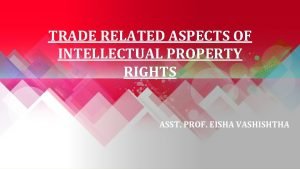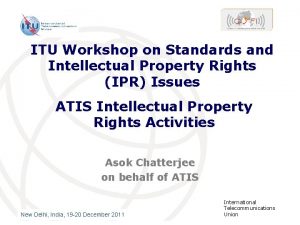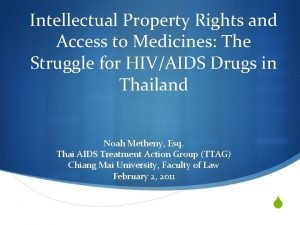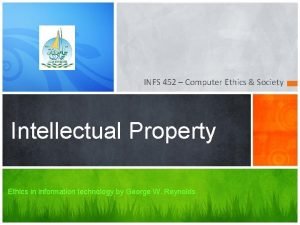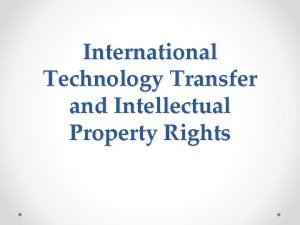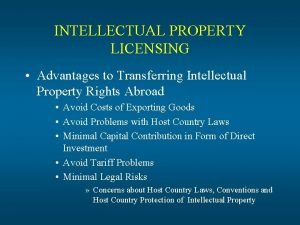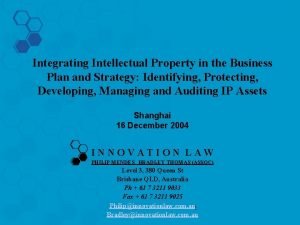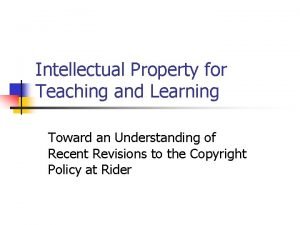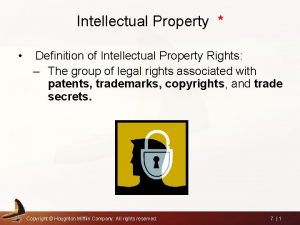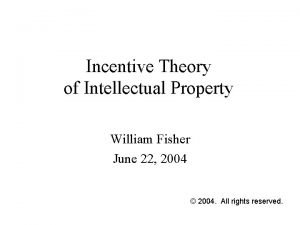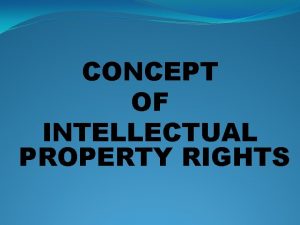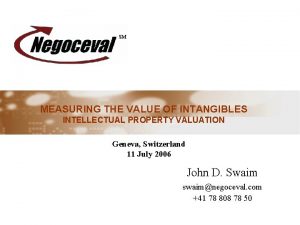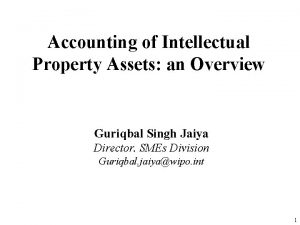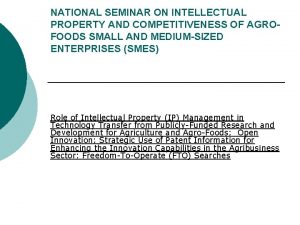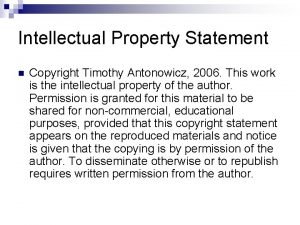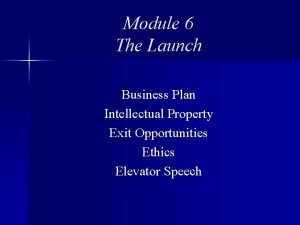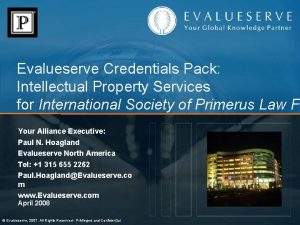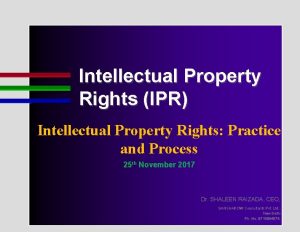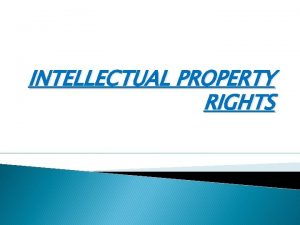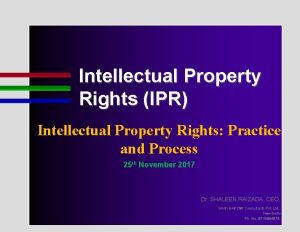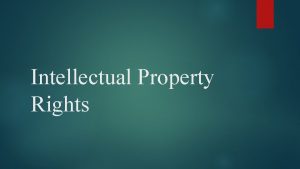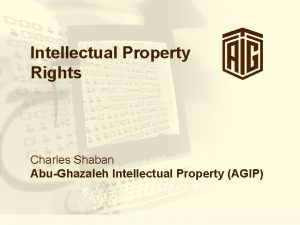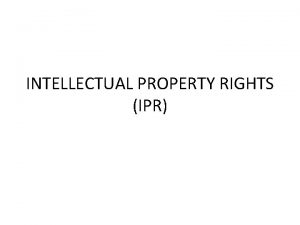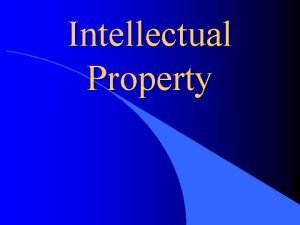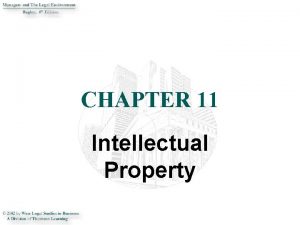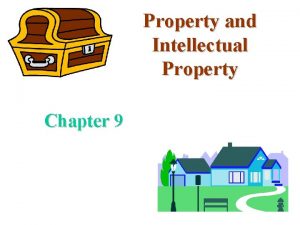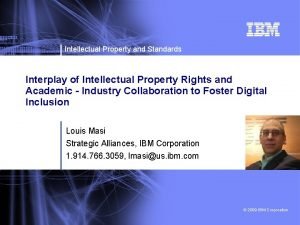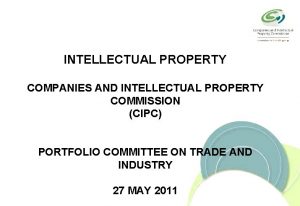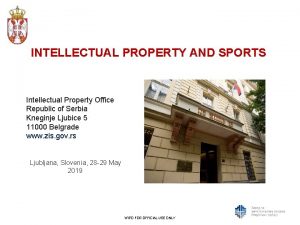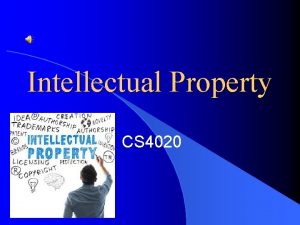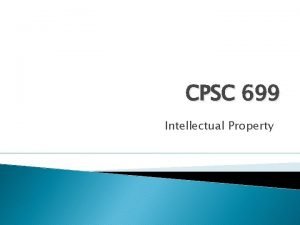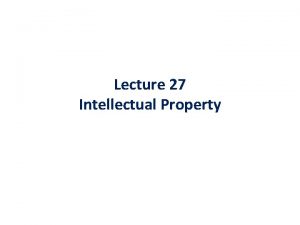1 Intellectual Property Rights and Computer Technology Chapter
























- Slides: 24

1 Intellectual Property Rights and Computer Technology Chapter 6 Ethical and Social. . . J. M. Kizza

2 Intellectual Property Rights and Computer Technology Computer Products and Services Instruments of Protection Ownership Infringement Protection of Ownership Rights The Legal Protection of Computer Software Ethical and Social. . . J. M. Kizza

3 Computer Products and Services Computer products Have a tangible form Have intrinsic value Computer services Have intrinsic value Have no tangible form Ethical and Social. . . J. M. Kizza

4 Computer products and services… Computer software A set of logical instructions in four forms: Logical map Source code Object code Executable code Has two forms Product Service May not have a tangible form Ethical and Social. . . J. M. Kizza

5 Computer Products and Services… Computer software categories: CANNED- off-the-shelf software Designer software – ordered by the customer Mixed – designer/canned If it is canned – it is a product If it is designer ordered – it is a service Otherwise a mixed case. Ethical and Social. . . J. M. Kizza

6 Foundations of Intellectual Property Rights Software is protected by Copyrights Rights enforceable by law Accorded to an artist, inventor/creator Should be an expression or creative works Literary, dramatic, musical, pictorial, graphics, artistic, audiovisual, architectural, or sound recording. The protected works must have: Tangible form Originality Fixation in a medium Ethical and Social. . . J. M. Kizza

7 Foundations of Intellectual Property Rights Copyrights are now universally accepted International enforcement conventions include: WIPO- world intellectual property organization UNESCO UCC- universal copyright convention WTO – World Trade Organization Once a copyright expires the work goes in public domain Ethical and Social. . . J. M. Kizza

8 Foundations of Intellectual Property Rights Public works include: Non-copyrightable items Ideas, facts, schedules, names, etc. . Copyrightable items Copyrights have expired Copyrightable works put in public domain by author Ethical and Social. . . J. M. Kizza

9 Foundations of Intellectual Property Rights Duration of copyrights: Depends on country U. S. Prior 1978 75 years from date of issue After 1978 lifetime of author plus 50 years Ethical and Social. . . J. M. Kizza

10 Foundations of Intellectual Property Rights Patents Protection of inventions and discoveries Requirements New and useful Improvement of any of the following: Process Manufacturing ( products that are not machines) Machines (covering mechanism, mechanical products & composition) Utility Novelty Nonobvious No disclosure. Protection duration in U. S. is 17 years Ethical and Social. . . J. M. Kizza

11 Foundations of Intellectual Property Rights Trade Secrets Information gives company competitive advantage No one specific definition of trade secrets Collection of information Static format Strategic importance Ethical and Social. . . J. M. Kizza

12 Foundations of Intellectual Property Rights Trade Secrets Duration is infinite if no disclosure The following characterize trade secrets Extent the information is known outside the business Extent of measures taken to protect the trade secrets Value of information to the owner Amount of money spent by owner to develop the information Ease/difficulty of acquiring such information Ethical and Social. . . J. M. Kizza

13 Foundations of Intellectual Property Rights Trademarks – product identifying labels Include: Service marks Certification marks Collective marks Characteristic of trademarks include Arbitrary marks (say nothing but used for service) Suggestive marks (symbols and writings) Descriptive marks (intended purposes) General marks (unrelated and not suggestive) Duration of trademarks in U. S. is 10 years Ethical and Social. . . J. M. Kizza

14 Foundations of Intellectual Property Rights Trademarks are registered in U. S. if they: Are in good taste for the public Have no suggestive connotations to their origin Are not symbols of any recognizable country Do not use people’s likeness without permission Ethical and Social. . . J. M. Kizza

15 Foundations of Intellectual Property Rights Personal Identity theft is a crime committed A person misrepresents oneself Intent Get the victim’s information Perpetrator can get goods & services in the victim's name. One of the fastest growing crime Ethical and Social. . . J. M. Kizza

16 Foundations of Intellectual Property Rights Identity theft techniques Advertising Newspapers Internet Most common technique - pretext calling, People misrepresent themselves Law enforcement agents Social workers Potential employers Goal - obtain the private data Sources of directions How-to books Discussion groups Internet Ethical and Social. . . J. M. Kizza

17 Foundations of Intellectual Property Rights Techniques steal personal identity include Telemarketing Fake Identifications Dumpster diving Going through trash Post office to redirect mail Eavesdropping Social engineering Prevention Personal awareness Education Ethical and Social. . . J. M. Kizza

18 Ownership Novel idea Original, authentic, and new Inventive and creative Come from individual Sources of substantial benefits to individuals and the public Useful Put into utilizable form - process or application. Ideas are in public domain Making them utilizable creates ownership Ethical and Social. . . J. M. Kizza

19 Infringement Using intellectual property rights without permission There are three types of infringements: Direct (full knowledge) Inducement Contributory Copyrights infringement: difficult to prove Infringer has knowledge or visual contact with the work. Individual claiming to be the owner has a valid copyright. Work under dispute is a major revision Substantially new contents versus a variation Patent and trademarks infringements: difficult to prove Ethical and Social. . . J. M. Kizza

20 Infringement Trademark infringement: Prove beyond doubt Infringer’s action was likely to confuse the public. Trade Secrets. Even more difficult. Ethical and Social. . . J. M. Kizza

21 Protection of ownership rights As owner/author of a creation, you’re protected by: Copyrights Patents Trademark Trade secrets Burden of safeguarding intellectual property rights – owner Methods vary Spying Using hired operatives Inspection Use of enforcement agencies Use of government (big companies) Ethical and Social. . . J. M. Kizza

22 First Sale Doctrine Copyright owner distribution rights Sale Transfer of ownership Rental Release Fair Use Doctrine Balance Protection of inventor/creator & benefits to the community Four ways to judge is fair use The purpose of use, commercial or educational Nature of use Percentage of use Effect on commercial value Ethical and Social. . . J. M. Kizza

23 Protection of ownership rights… Property Rights Laws based on types Copyrights Country dependent Right to use, transform, sale, copy, and modify Patents: country dependent Trademarks: state and country dependent Trade secrets Country States Local authority Ethical and Social. . . J. M. Kizza

24 Ethical Issues in the Digital Age Piracy Right of owner Internet influence Ethical and Social. . . J. M. Kizza
 Trade-related aspects of intellectual property rights
Trade-related aspects of intellectual property rights Intellectual property in professional practices
Intellectual property in professional practices Intellectual property rights
Intellectual property rights Intellectual property rights
Intellectual property rights Intellectual property in computer ethics
Intellectual property in computer ethics Importance of intellectual property
Importance of intellectual property Intellectual property management definition
Intellectual property management definition Licensing advantages
Licensing advantages Intellectual property business plan example
Intellectual property business plan example Right to intellectual property of teachers
Right to intellectual property of teachers Intellectual property definition
Intellectual property definition Theories of intellectual property william fisher
Theories of intellectual property william fisher Concept of intellectual property
Concept of intellectual property Intellectual property valuing
Intellectual property valuing Characteristics of intellectual property
Characteristics of intellectual property Discuss intellectual property frankly
Discuss intellectual property frankly Intangible inputs
Intangible inputs Intellectual property
Intellectual property Intellectual property statement
Intellectual property statement Intellectual property business plan example
Intellectual property business plan example Evalueserve intellectual property
Evalueserve intellectual property Discuss intellectual property frankly
Discuss intellectual property frankly At&t ecommerce
At&t ecommerce Positive rights vs negative rights
Positive rights vs negative rights Duty towards self
Duty towards self
